| Now that you've created all these great Web pages, it's time to organize them with a site menu and for that, we'll need the Site Menu template. A site menu provides visitors with a high-level overview of the pages in a site that you've created using your .Mac account. The site menu should be one of the last things you do when creating a site it's the bit that ties together a bunch of disparate pages into a coherent whole. To create a site menu 1. | Log in to your .Mac account using a Web browser, and click the HomePage link.
The main HomePage page loads.
| 2. | In the left column, at the top of the page, select the site for which you want to create a site menu, and then click the Site Menu tab (Figure 4.53).
Figure 4.53. The first step in creating a site menu is to select the site in the Sites column and then select the Site Menu tab to load the Site Menu template set. 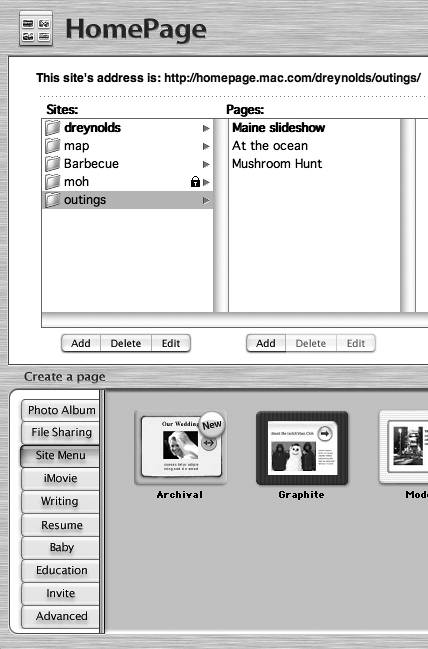
The Site Menu templates load.
| 3. | Click a Site Menu template.
The "Edit your page" page loads for that selected template. This page shows all of the site's individual Web pages.
| 4. | Fill in all of the text fields, writing a title and description for the page, and a title and description for each item (Figure 4.54).
Figure 4.54. To complete a Site Menu, fill in a title for the page, and a title and description for each item on the page. 
| 5. | To choose a different picture to represent a specific photo album on the site menu, click Choose and select a new picture in the "Choose a file" page (Figure 4.55).
Figure 4.55. Click the picture you want to use as the representative graphic for the site menu item, and then click Choose to set the image. 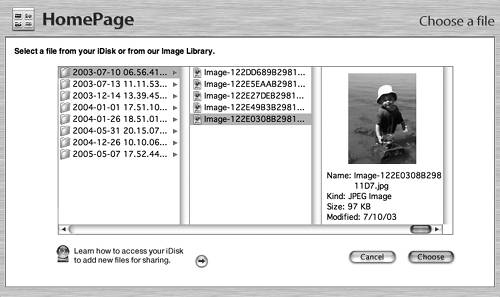
| 6. | To remove a page from the site menu you are creating, click the Minus button next to each page you want removed from the site menu (Figure 4.56).
Figure 4.56. To remove an item from a site menu page, click the Minus button in its upper right corner. 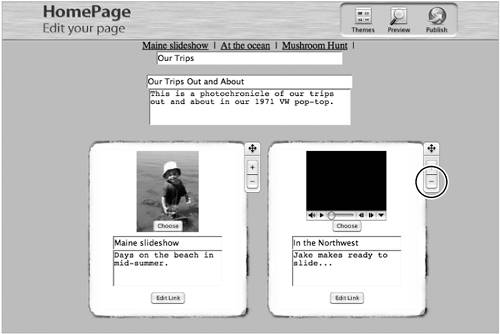
The page reloads sans the items you clicked.
| 7. | To add a new page (or external link) to the site menu you are creating, click the Plus button next to the item you want to have appear before the new page or link (Figure 4.57).
Figure 4.57. To add a new item linking to another page (or to an e-mail address), click the Plus button in the upper right corner of the item you want to have appear before the new item. 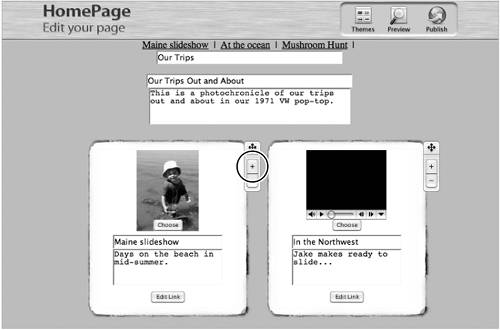
The page reloads with a new item. See the sidebar "Adding Links to Your Site Menu" for details on how to do this.
| 8. | To reposition an item on the site menu page, drag the crossed-arrows icon to the right of the item to move it (Figure 4.58).
Figure 4.58. Repositioning items on a site menu page is as easy as dragging the upper right corner of the item until the item is where you want it to be place it between two items to have the moved item appear between them. 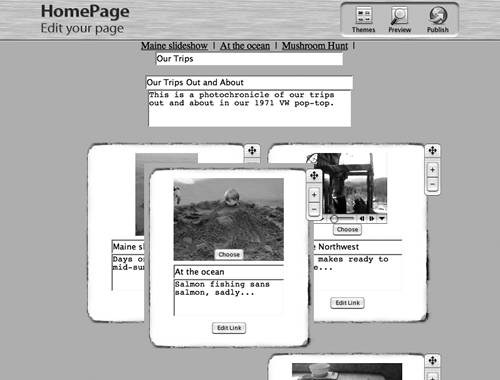
| 9. | To preview your site menu before publishing it, click the Preview button in the upper right corner of the page.
| 10. | If you're satisfied, click the Publish button at the top of the page.
Your site menu page is published, and the Congratulations page loads with the URL to your new page.
|
Adding Links to Your Site Menu Remember that Plus (+) button next to each item on the Site Menu template (Figure 4.59)? That button lets you link to the following items from your site menu: Figure 4.59. Each item on a site menu page has a Plus button to the right near the top part of a cluster of three buttons. Clicking the Plus button allows you to add a new item to your site menu page after the item on which the Plus button was pushed. 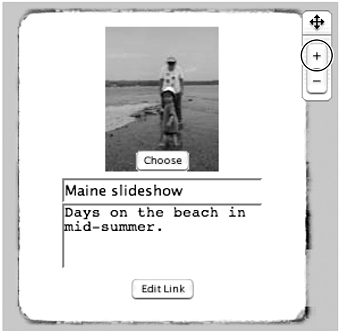
To create a section that links to any of these items from your site menu, click the Plus button next to the Web page to which you want to add the link. Don't worry, you won't remove the existing page the section for adding the link appears below it. Customize this one as you would any other section within a site menu page by typing a title and description and choosing a graphic element (Figure 4.60). Figure 4.60. A new item on a site menu page is mostly blank it's up to you to select a graphic and type in a page title and description. 
To create the new link, click the Edit Link button. The "Edit your links" page opens. Select from the My Pages, Other Pages, and Email tabs (Figure 4.61). Here's what each one does: My Pages This tab lets you link only to pages that you've created through your .Mac account. On the My Pages tab, select a page to link to it from the site menu and click Apply. Other Pages This tab lets you link to pages other than the ones you've created yourself through your .Mac account. On the Other Pages tab, type in the URL of the page you want to link to from the site menu in the field, and click Apply. Email This tab lets you link an item on your Web page to an e-mail address. On the Email tab, type the e-mail address that you'd like to link to in the field, and click Apply.
Figure 4.61. By clicking the Edit Link button on an item in a site menu, you can link to another .Mac element, a Web page outside of .Mac, or an e-mail address. 
|
|








